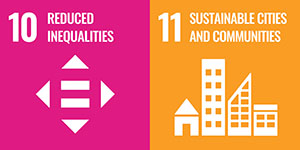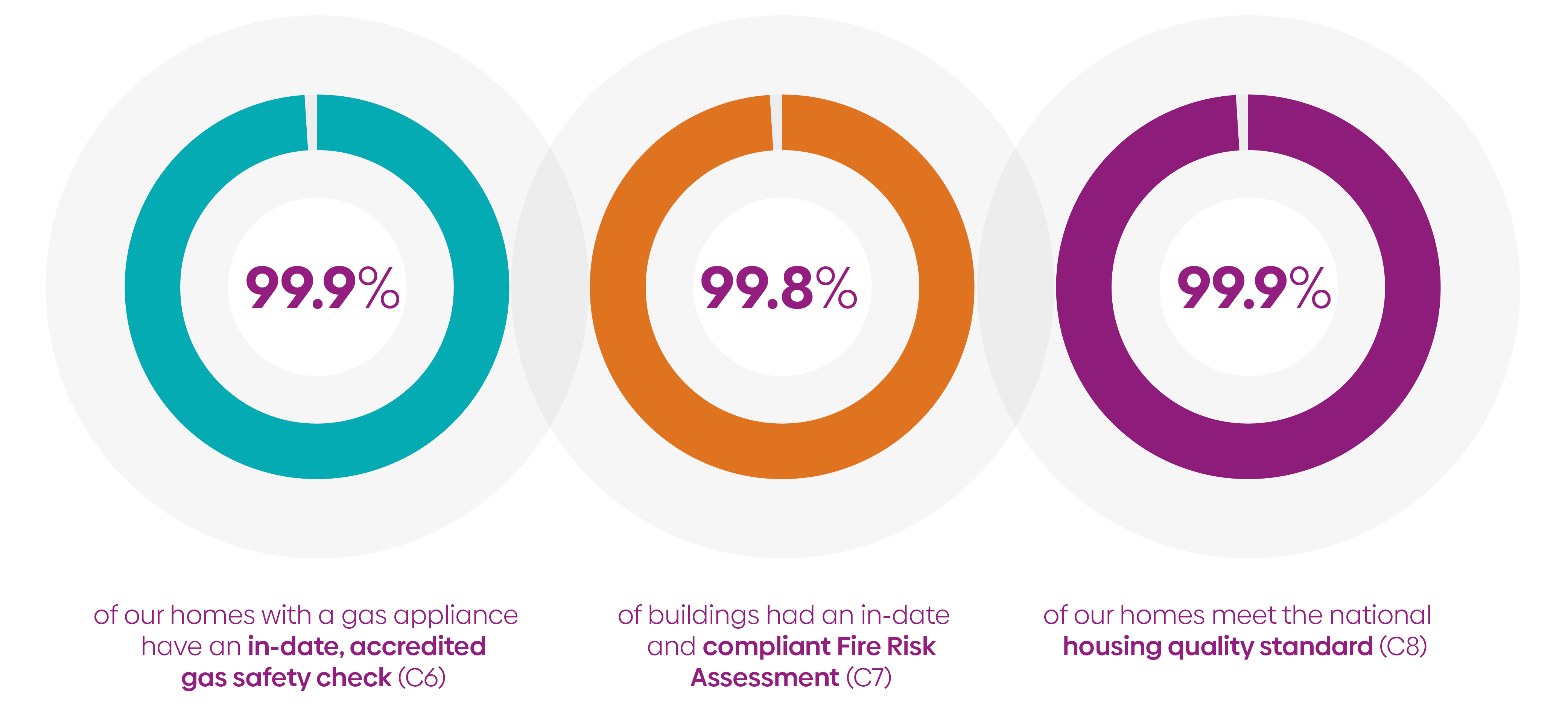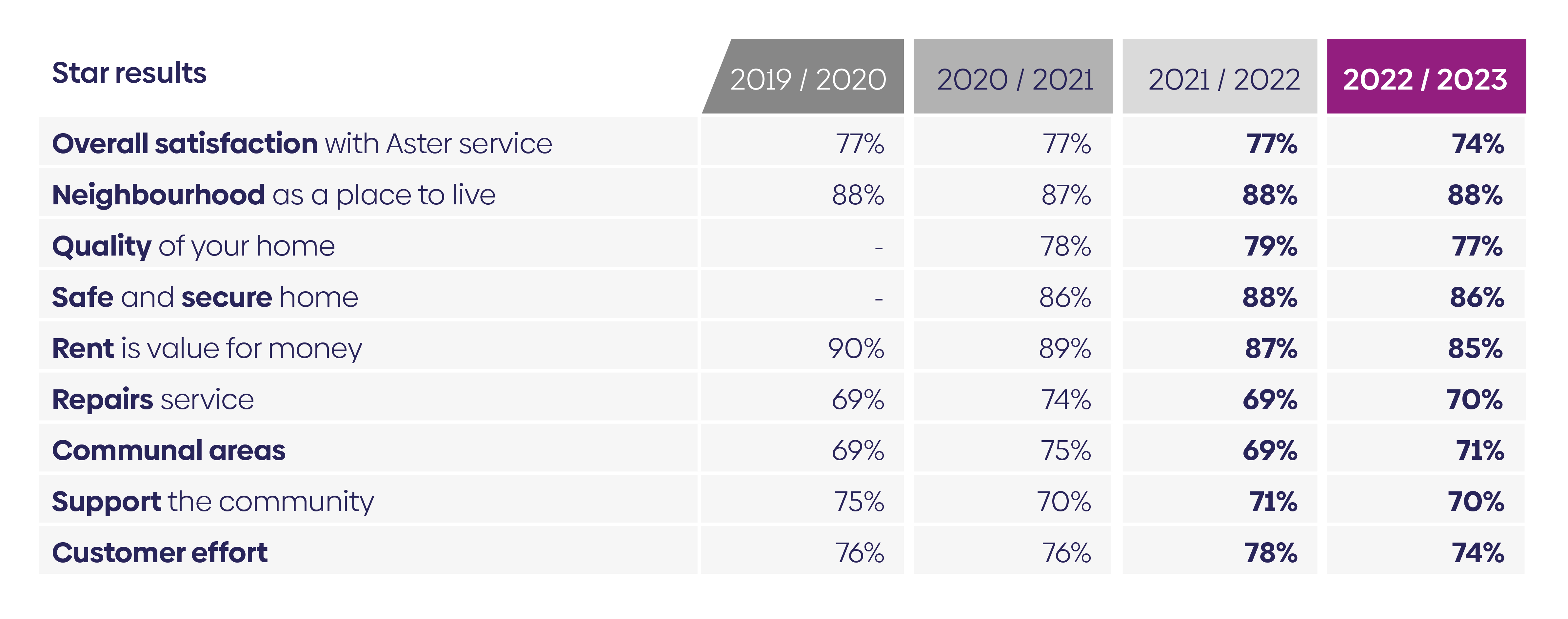Affordability & Security
T1
C1 - For properties that are subject to the rent regulation regime, report against one or more Affordability Metric:
Rent compared to Median private rental sector (PRS) rent across the Local Authority (c1.01) - 53.88%
Rent compared to Local Housing Allowance (LHA) - 64.17%
C2 and C3 – Number of homes
Homes and bed spaces in management and in development
New homes
In the year to the end of March 2023, the housing association built:
- 698 homes for affordable and social rent
- 466 shared ownership properties
- 17 for market rent
C4 – How is the Housing Provider trying to reduce the effect of fuel poverty on its residents?
The Financial Wellbeing team support our customers in many ways to ensure they have a healthier relationship with money and that they are getting all of the benefits they need. In 2022/23, they have supported over 2,000 households to maximise their incomes, and offered direct support by way of food and fuel vouchers or payments to over 500 households in acute financial crisis.
As a responsible landlord, we are already delivering a lot of support through our Financial Wellbeing team and our property investment programmes. However, the scale of the recent crisis is likely to bring many more households into fuel poverty. As a way to prioritise those most likely to be struggling we have developed a fuel poverty intervention targeting tool. The tool analyses each address on key property and customer criteria that Aster holds, which may indicate that a customer is more likely to be in fuel poverty. We contacted just over 300 customers we identified as most at risk and offered them additional support in the form of low cost, easy to fit energy saving measures. Around 10% requested the packs.
C5 –What % of rental homes have at least a 3 year tenancy agreement?
99.9%
Aligns with SDG goals: 
Building Safety & Quality
T2
What % of homes with a gas appliance have an in-date, accredited gas safety check? 99.95%
What % of buildings have an in-date and compliant Fire Risk Assessment? 99.82%
What % of homes meet the national housing quality standard? 99.99%

Aligns with SDG goals:

Resident Voice
T3
Listening to our customers is something we take seriously at Aster. We have a number of ways in which customers can get involved, from holding our Board to account, to providing feedback to shape and co-design our services to enable us to improve. Our customers are embedded into our governance and scrutiny framework through three core groups.

The customer overview group (COG) and the customer scrutiny panel (CSP) support the work of the customer and communities network (CCN), a supporting governing body that feeds directly into our boards. CCN consists of customers, Executive and Non-Executive Directors, with the responsibility for scrutinising and challenging our performance, how we deliver services to our customers, and onward recommendation of customer related policies. COG is made up of a group of customers who review and approve customer facing policies and procedures and make recommendations on how services are best delivered for our customers and strategies. The Customer Scrutiny Panel provides a thorough and customer focused assessment of our services and processes.
C10 - How does the housing provider measure Resident Satisfaction and how has Resident Satisfaction changed over the last three years?
The STAR (Survey of Tenants and Residents) survey continued to measure customer perception every quarter throughout FY22/23. From April 2023 we moved away from the STAR survey to base our perception survey on the Regulator's new tenant satisfaction measures (TSMs). In addition to the STAR survey a number of transactional surveys are in place to measure customer satisfaction with specific services. See separate tab for trend over last three years.

C11 – Complaints and the Ombudsman
Aster Severe Maladministration - 1
Maladministration - 3
Partial - 3
CCHT Partial - 2
We are committed to learning from all of our complaints, and will always look at how we can improve our practices. A dedicated complaint learning group has been formed to ensure the opportunities to identify and implement learning are maximised. The role of the group includes reviewing and challenging complaint learning identified by the process and driving improvements in assessing learning across the business. We monitor and report any learning from Ombudsman findings of maladministration and complaint failure orders. We then identify the impact of learning from complaints on relevant existing policies and monitor any changes necessary.
Following our determination of severe maladministration, a full learning review has taken place, and implementation of that learning is being monitored. As a direct result of this complaint, we have updated our ‘lettable standard’ for accessible homes so for example, as a minimum, we should always fit appropriate flooring in these homes. We’ve also worked with specialists to review our training, so services are delivered in the most accessible way. In line with the Equality Act, colleagues complete mandatory training which provides the skills to give customers the best possible experience.
Since 2020, when this complaint was made, we’ve reviewed our internal lettings process and complaints procedures. We’ve rolled out additional training for our complaints team and updated our processes to help customers with vulnerabilities and / or disabilities get individual support throughout the lettings process. In 2020 we introduced virtual viewings for our customers, which would have benefitted our customer in this case, had it been available at the time.
We amended our management move process following a recommendation from the Ombudsman. This now clearly sets out our position on the size of property that a household will be entitled to.
We amended our wording around when cyclical replacements are due to make it more clear.
Aligns with SDG goals: 
Resident Support
T4
C12 - What support services does the Housing Provider offer to its residents. How successful are these services in improving outcomes?
- In 22/23, 4,031 people were positively impacted by Aster Foundation programmes; over 9,200 people since 2021.
- 2,124 people have been supported with their mental wellness or social connectivity
- 1,775 people were supported to be financially included
- 132 people have had support with improving their chances of employment (this a developing area)
- The enablers to us delivering our work are social research which engaged 574 people and volunteering which invested 134 days of support through 22/23
More detail can be found in our Aster Foundation Impact Report
Aligns with SDG goals: 
Placemaking
T5
C13 - Provide examples or case studies of where the Housing Provider has been engaged in placemaking or placeshaping activities.
We are the leading housing association provider of Community Land Trust partnerships, having delivered 13 schemes to date and forecast to double the number of CLT homes in our portfolio by 2028. CLT partnerships are a powerful way for local communities to drive housing developments that meet their specific housing needs. They also provide much needed facilities and public spaces to enhance the local area. We’re in contract and planning permission has been secured for the following CLT schemes:
- Chawleigh CLT – 10 homes for social rent
- Longhope CLT – 12 homes for social rent
- Hartland CLT – 10 homes for social rent
- With three further CLTS set to deliver 95 homes with planning permission, subject to final contracts
We pay a ground rate to all our CLTs and this money is used to benefit the community mostly through small scale projects such as free messy play sessions for toddlers in a village hall, improving stiles/footpaths in the parish and upgrading sports facilities.
Neighbourhood enhancements
Each year we also invest in neighbourhood enhancement projects, collaborating with our customers to make improvements across our estates. One example from 2022/23 was on Bellevue Road, Devizes where we protected the grassy areas and improved the look and feel of the neighbourhood. Grassy areas were getting churned up by cars parking directly outside our customers’ homes and it had also become a hazard when it rained. We invested over £20,000 to install bollards to protect the grass and as part of this project, we also created seven new parking spaces for customers to use.
A customer told us: "It looks much better and I'm happy as cars were constantly parking under my window." Another added: “The area looks much nicer now that the cars can’t park all along the grass."
Aligns with SDG goals: 